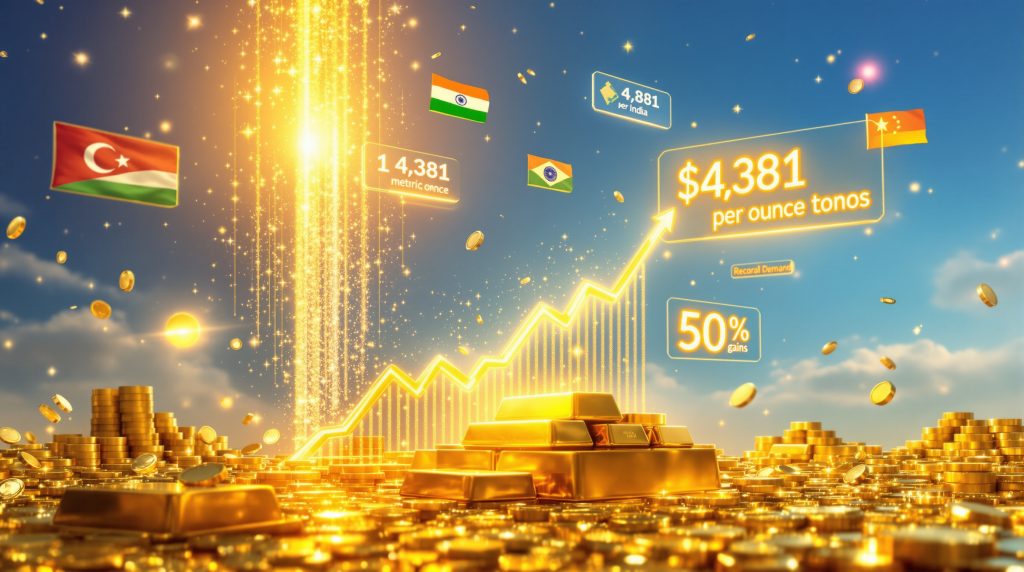Understanding the Forces Behind Global Gold Demand
The precious metals landscape witnessed an unprecedented transformation during the third quarter of 2025, as global gold demand reached historic heights of 1,313 metric tons, marking a 3% year-over-year increase that shattered all previous quarterly records. This remarkable surge represents far more than statistical achievement, signalling a fundamental restructuring of how investors, institutions, and governments perceive gold's role in modern portfolios.
The convergence of multiple market forces created perfect conditions for this extraordinary performance. Investment categories experienced explosive growth while traditional consumption patterns adapted to elevated price levels. Central banking institutions accelerated their strategic accumulation programmes, and regional markets demonstrated varying responses to changing economic conditions. Furthermore, our comprehensive all-time gold highs analysis reveals that gold prices achieved an all-time peak of $4,381 per ounce on October 20, 2025, delivering a remarkable 50% year-to-date return that captured global attention.
This multifaceted demand surge reflects deeper structural changes within global financial markets. Traditional jewellery consumption, historically the dominant category, yielded leadership to investment-focused purchasing. The shift indicates evolving investor psychology, institutional strategies, and monetary policy responses to contemporary economic challenges. Understanding these dynamics provides crucial insight into precious metals markets and their expanding role in wealth preservation strategies.
How Investment Demand is Reshaping Gold Markets
Physical Gold Investment Acceleration
The most striking development during Q3 2025 involved the explosive growth in physical gold investment demand. Bar and coin purchases surged 17% during the quarter, dramatically outpacing traditional consumption patterns and establishing investment demand as the fastest-expanding segment of the global market. This growth rate represents a significant acceleration from previous quarters and indicates sustained retail and institutional appetite for tangible precious metals exposure.
Regional leadership patterns revealed important market dynamics. India and China emerged as dominant forces driving this investment surge, with their combined purchasing power reshaping global distribution networks. India's traditional cultural affinity for gold evolved beyond ceremonial and jewellery purposes toward systematic investment accumulation. Chinese market participants, supported by expanding middle-class wealth and evolving investment education, increasingly viewed physical gold as portfolio diversification essential.
The psychology driving this surge extends beyond traditional safe-haven motivations. Market analysts identified a pronounced "fear-of-missing-out" or FOMO buying phenomenon that amplified demand during price appreciation periods. This behavioural pattern created momentum-driven purchasing cycles, where rising prices paradoxically encouraged additional buying rather than typical demand destruction.
Key factors supporting physical investment growth include:
• Wealth preservation strategies amid currency debasement concerns
• Portfolio diversification requirements for institutional mandates
• Inflation hedging capabilities demonstrated during recent economic cycles
• Geopolitical risk management as global tensions elevated uncertainty
Exchange-Traded Fund Revolution
The transformation within gold-backed exchange-traded funds reached unprecedented levels during Q3 2025, with inflows surging 134% compared to previous quarters. This explosive growth reflects the maturation of ETF products as preferred vehicles for precious metals exposure, combining the benefits of gold ownership with the liquidity and convenience of equity markets.
The ETF revolution appealed to diverse investor categories for distinct reasons. Institutional participants valued the operational efficiency, regulatory compliance, and audit transparency that established ETF providers offered. Retail investors appreciated the accessibility, fractional ownership capabilities, and elimination of storage and insurance concerns associated with physical possession.
Critical advantages driving ETF adoption include:
| Feature | Traditional Physical Gold | Gold ETFs |
|---|---|---|
| Minimum Investment | Typically 1-ounce coins/bars | Fractional shares available |
| Storage Requirements | Secure vault or safe deposit box | None (electronic custody) |
| Liquidity | Dealer networks, potential spreads | Real-time trading during market hours |
| Insurance Costs | Separate premium required | Included in management fees |
| Audit Verification | Personal responsibility | Professional third-party auditing |
The technological infrastructure supporting ETF growth evolved significantly, with blockchain verification systems and real-time inventory tracking enhancing investor confidence. Major ETF providers expanded their physical gold holdings to unprecedented levels, creating substantial demand for newly-mined and recycled metal to meet redemption requirements.
Market analysts emphasise that investment demand now represents the fastest-growing segment of global gold consumption, fundamentally altering traditional market dynamics and creating sustained pressure on available supply.
Why Are Central Banks Accelerating Gold Purchases?
Strategic Reserve Diversification Initiatives
Central banking institutions demonstrated renewed commitment to gold accumulation during Q3 2025, purchasing 219.9 tons and achieving a 10% quarter-over-quarter growth rate. This substantial acquisition activity contributed to year-to-date purchases of 634 tons through September, positioning annual accumulation well above historical baseline levels whilst trailing the exceptional peaks reached during 2022-2024.
The strategic rationale behind accelerated central bank purchasing reflects sophisticated risk management approaches. Monetary authorities recognise gold's unique properties as a reserve asset that maintains value independence from any single currency or political system. Unlike traditional foreign exchange reserves concentrated in major currencies, gold provides diversification benefits that strengthen overall reserve portfolio resilience.
Annual trajectory analysis reveals:
• 2025 projected total: Approximately 845 tons based on current accumulation pace
• Historical context: Substantially exceeds pre-2022 baseline averages
• Regional distribution: Emerging market economies leading purchase activity
• Purchase transparency: Mix of reported and estimated acquisition patterns
Geopolitical Risk Management Evolution
The intensification of geopolitical tensions throughout 2025 elevated gold's importance as a sanctions-resistant reserve asset. Central banks increasingly recognised that traditional reserve currencies, whilst offering liquidity advantages, carry counterparty and political risks that gold ownership eliminates entirely. This realisation accelerated diversification initiatives across multiple monetary systems.
Monetary authorities particularly focused on reducing excessive concentration in any single currency system. The dollar-dominated international monetary framework, whilst remaining globally significant, prompted central banks to establish more balanced reserve compositions. Gold purchases represented a systematic approach to achieving this rebalancing without destabilising existing international relationships.
Key risk management considerations include:
• Sanctions immunity: Gold holdings resist external political interference
• Currency diversification: Reduces dependence on major currency fluctuations
• Monetary system evolution: Preparation for potential structural changes
• Emergency liquidity: Collateral capabilities for international financing
Leading Central Bank Buyers and Market Impact
Emerging market economies dominated central bank purchasing activity, with Turkey, India, and China establishing leadership positions in gold accumulation strategies. These countries' purchasing patterns reflect broader emerging market perspectives on reserve adequacy and monetary independence. Their combined buying power created sustained demand that contributed significantly to overall market tightness.
Brazil's market re-entry after a four-year absence represents a particularly significant development. This return signals expanding Latin American interest in gold reserve diversification and suggests potential for additional regional central banks to initiate or resume accumulation programmes. Brazil's purchasing decision likely reflects evolving perspectives on reserve optimisation and regional monetary stability requirements.
The distinction between reported and estimated central bank purchases highlights transparency variations across monetary systems. Whilst some central banks publicly announce their gold transactions, others maintain operational secrecy that requires market analysts to estimate activity levels based on import data, mining statistics, and inventory tracking.
Notable purchasing patterns include:
| Country/Region | Q3 2025 Activity | Strategic Focus |
|---|---|---|
| Turkey | Continued accumulation | Regional stability, currency support |
| India | Consistent purchasing | Reserve adequacy, dollar diversification |
| China | Systematic accumulation | Strategic reserve building |
| Brazil | Market re-entry | Regional monetary leadership |
What Economic Factors Are Propelling Gold Prices?
Macroeconomic Uncertainty Drivers
The extraordinary price performance that culminated in gold reaching $4,381 per ounce reflected multiple converging macroeconomic pressures. Interest rate expectations played a crucial role, as market participants anticipated Federal Reserve policy adjustments that would reduce the opportunity cost of holding non-yielding assets. Lower real interest rates historically correlate strongly with gold price appreciation, creating favourable conditions for precious metals investment.
Dollar weakness concerns contributed significantly to gold's appeal among international investors. Currency debasement fears, driven by expansive fiscal policies and mounting sovereign debt levels, encouraged portfolio managers to seek assets with intrinsic value and historical purchasing power preservation. Meanwhile, the continuing gold market surge demonstrates gold's performance during previous currency crises established its credibility as a hedge against monetary debasement.
Stagflation threats emerged as a particularly compelling factor supporting gold demand. The combination of economic growth concerns with persistent inflation pressures created an environment where traditional asset classes struggled to provide adequate protection. Gold's historical performance during stagflation periods, particularly the 1970s, reinforced its appeal as a portfolio hedge against this challenging economic scenario.
Technical Price Performance Analysis
The 50% year-to-date appreciation through October 2025 represents one of gold's strongest annual performances in decades. This remarkable gain exceeded most professional forecasts and attracted significant attention from institutional investors previously underweight precious metals. The price trajectory demonstrated sustained momentum rather than speculative volatility, suggesting fundamental demand drivers supported the appreciation.
Key performance metrics include:
• January 2025 starting price: Approximately $2,920 per ounce
• October 20, 2025 peak: $4,381 per ounce (record high)
• Percentage gain: 50% year-to-date performance
• Volatility characteristics: Steady appreciation rather than speculative spikes
Technical analysis revealed strong support levels throughout the price advance, with momentum indicators suggesting sustained demand rather than temporary buying pressure. Options market activity showed increased call option interest, indicating investor expectations for continued appreciation. However, the rapid price advance also created potential for profit-taking activity that could introduce short-term volatility.
Safe-Haven Demand and Market Psychology
Geopolitical tensions throughout 2025 reinforced gold's traditional safe-haven appeal. US tariff uncertainty contributed to market nervousness, as trade policy developments created unpredictable impacts on global economic growth. International tensions elevated risk premiums across asset classes, with gold benefiting from its historical role as a crisis hedge.
The emergence of FOMO buying behaviour represented a significant psychological shift in precious metals markets. Traditional gold demand patterns typically involved contrarian purchasing during market stress, but 2025 witnessed momentum-driven buying that accelerated during price advances. This behavioural change suggested broader investor familiarity with gold as an asset class and reduced stigma around precious metals ownership.
Market psychology factors include:
• Institutional FOMO: Professional managers increasing allocations to avoid underperformance
• Retail momentum: Individual investors following price trends
• Media attention: Increased coverage driving awareness and interest
• Social proof: Success stories encouraging additional participation
How Are Regional Markets Contributing to Global Gold Demand?
Asian Market Leadership and Cultural Dynamics
India and China's combined dominance in bar and coin demand reflects deep cultural relationships with gold ownership alongside evolving investment sophistication. India's traditional gold affinity, historically concentrated in jewellery and ceremonial purposes, increasingly expanded toward systematic investment accumulation. The timing of Q3 2025 demand growth aligned with pre-festival preparation periods, as consumers anticipated seasonal celebrations requiring gold purchases.
Chinese market evolution demonstrated particularly sophisticated development patterns. Rising middle-class wealth creation, supported by urbanisation trends and technology sector growth, provided expanded capital for precious metals investment. Chinese investors increasingly viewed gold as portfolio diversification essential, moving beyond traditional savings accounts toward hard asset accumulation strategies.
Regional demand characteristics include:
• India: Festival seasons, wedding preparations, systematic investment programmes
• China: Wealth management expansion, property market diversification, currency hedging
• Southeast Asia: Growing middle-class participation, Islamic finance integration
• Japan: Institutional allocation increases, pension fund diversification
Supply chain infrastructure development supported regional demand growth. Local refineries, distribution networks, and storage facilities expanded capacity to meet increasing consumption. Premium structures (price above spot gold) varied significantly across regions, with tighter supply chains commanding higher premiums and indicating strong local demand conditions.
Western Investment Patterns and Institutional Adoption
Western markets demonstrated distinct investment patterns focused on portfolio diversification and professional money management strategies. Institutional investors, including pension funds, insurance companies, and endowments, systematically increased precious metals allocations to meet risk management mandates. Modern portfolio theory applications suggested gold allocations between 5-10% of balanced portfolios, with many institutions historically underweight this target.
Hedge fund strategies evolved beyond simple long bullion positions toward sophisticated approaches including gold mining equity exposure, currency pairs trading, and structured derivatives. Professional money managers increasingly recognised gold's correlation benefits, as precious metals typically demonstrated negative correlation with equity markets during stress periods.
Retail investor education programmes expanded significantly, with financial advisors incorporating precious metals education into client presentations. Online platforms simplified gold investment access, whilst educational content explained gold's role in inflation protection, currency hedging, and portfolio risk reduction.
| Region | Primary Demand Drivers | Investment Vehicles |
|---|---|---|
| North America | Portfolio diversification, inflation hedging | ETFs, mining stocks, physical coins |
| Europe | Currency diversification, geopolitical hedging | Physical bars, ETFs, structured products |
| Australia | Mining industry familiarity, Asian market proximity | Physical ownership, mining equities |
What Supply Dynamics Are Meeting This Unprecedented Demand?
Mining Production and Global Output Trends
Global mine production increased by a modest 2% during Q3 2025, significantly lagging the 3% demand growth and creating fundamental supply-demand imbalances that supported price appreciation. This production growth rate reflects structural challenges within the mining industry, including ore grade decline, regulatory complexities, and capital allocation constraints that limit rapid capacity expansion.
Major mining regions contributed varying production levels:
• South Africa: Continued production from deep-level mines despite operational challenges
• Australia: Maintained steady output from established operations
• Russia: Production levels affected by international sanctions and market access
• Canada: Expanded output from newer mining projects in favourable geological regions
The 2% production increase represents significant achievement considering industry-wide challenges. Mining companies faced persistent inflation in energy, labour, and equipment costs, whilst environmental regulations required additional compliance investments. Exploration budgets, whilst recovering from previous decade lows, remained insufficient to replace depleted reserves at rates matching demand growth.
Critical production constraints include:
• Ore grade decline: Average gold content per ton continues decreasing globally
• Energy costs: Mining operations require substantial electricity and fuel inputs
• Environmental compliance: Stricter regulations increase operational complexity
• Capital intensity: New mine development requires multi-year, billion-dollar investments
Recycling Market Contributions and Secondary Supply
Recycled gold supply increased by 6% during Q3 2025, demonstrating price-responsive behaviour as higher gold values encouraged scrap metal recovery. This secondary supply source provided crucial market flexibility, helping meet demand surges without requiring expanded primary production. Recycling operations benefited from improved recovery technologies and expanded collection networks.
Recycling sources include:
• Jewellery scrap: Consumers selling existing pieces due to attractive prices
• Electronic waste: Recovered from discarded devices and industrial equipment
• Industrial byproducts: Manufacturing processes generating recoverable gold content
• Investment liquidation: Bar and coin sales during price peaks
Technology advancements enhanced recycling efficiency, with refined processing techniques recovering higher percentages of gold content from complex electronic components. Urban mining operations expanded capacity to handle growing electronic waste streams, whilst improved logistics networks reduced collection and processing costs.
The 6% recycling increase provided approximately 75-85 tons of additional supply during Q3 2025, representing meaningful contribution to overall market balance. However, recycling supply remains inherently limited by available scrap material and typically responds to price changes with significant time lags.
Supply-Demand Balance and Market Equilibrium
The combination of 2% mining production growth and 6% recycling increases resulted in record quarterly supply levels that nonetheless struggled to match unprecedented demand. This supply-demand imbalance created fundamental support for price appreciation and suggests continued market tightness absent significant demand moderation or supply expansion.
Market equilibrium factors include:
| Supply Component | Q3 2025 Change | Market Impact |
|---|---|---|
| Mine Production | +2% | Modest increase, insufficient for demand |
| Recycled Gold | +6% | Price-responsive, limited by scrap availability |
| Central Bank Sales | Minimal | Net purchasers rather than suppliers |
| ETF Redemptions | Limited | Strong inflows rather than outflows |
Future supply constraints present significant challenges for market balance. New mine development requires 7-10 year timelines from discovery to production, whilst existing mines face declining ore grades and rising extraction costs. Exploration spending, though recovering, remains below levels required to replenish reserves at current consumption rates.
Investment implications suggest continued supply tightness absent major demand destruction from higher prices or significant new mine discoveries. The structural nature of supply constraints indicates potential for sustained elevated price levels rather than temporary market imbalances.
How Is Jewellery Demand Responding to Price Pressures?
Fabrication Decline Analysis and Market Adaptation
Jewellery fabrication experienced a sharp 23% decrease to 419.2 tons during Q3 2025, representing the most significant demand destruction category as elevated gold prices affected consumer purchasing decisions globally. This substantial decline reflected price sensitivity within traditional consumption markets, where discretionary jewellery purchases proved vulnerable to affordability constraints.
Regional variations in jewellery demand revealed important market adaptation strategies. Indian consumers, traditionally the world's largest jewellery market, demonstrated some resilience through cultural purchasing obligations despite price pressures. Chinese jewellery demand showed greater price elasticity, with consumers delaying discretionary purchases or seeking alternative materials.
Western jewellery markets adapted through product innovation and marketing strategies:
• Lighter weight designs: Maintaining aesthetic appeal whilst reducing gold content
• Alternative alloys: Higher silver or copper content in gold jewellery
• Financing options: Extended payment plans to maintain affordability
• Trade-in programmes: Encouraging existing jewellery upgrades rather than new purchases
Consumer Behaviour Shifts and Substitution Effects
The 23% fabrication decline triggered significant consumer behaviour adaptations as traditional jewellery buyers sought alternatives to maintain their cultural and aesthetic preferences. Substitution effects became particularly pronounced in markets where jewellery serves ceremonial or cultural functions that cannot be easily eliminated.
Price-responsive consumer strategies include:
• Purchase timing delays: Awaiting potential price corrections before major acquisitions
• Quality adjustments: Accepting lower karat gold content to maintain affordability
• Alternative materials: Increased interest in silver, platinum, or gold-filled jewellery
• Second-hand markets: Growing participation in estate and vintage jewellery segments
Cultural considerations proved particularly important in maintaining demand despite price pressures. Indian wedding seasons and religious festivals continued driving essential jewellery purchases, though consumers increasingly optimised timing and selection to minimise costs. Chinese New Year and other traditional celebrations maintained jewellery demand, albeit with modified purchasing patterns.
Market adaptation innovations emerged across the jewellery supply chain:
| Adaptation Strategy | Implementation | Market Impact |
|---|---|---|
| Design Innovation | Hollow construction, mixed metals | Maintains appearance, reduces costs |
| Financing Solutions | Buy-now-pay-later, layaway programmes | Sustains demand despite price pressure |
| Digital Integration | Online customisation, virtual try-on | Reduces overhead costs, improves accessibility |
| Recycling Programmes | Trade-in incentives, upgrade programmes | Encourages continued market participation |
What Do Market Experts Predict for Future Global Gold Demand?
Analytical Forecasting and Market Outlook
Leading market analysts maintain optimistic perspectives regarding global gold demand sustainability, emphasising structural factors that support continued growth beyond short-term price volatility. In addition, research from the World Gold Council indicates the market remains far from saturation, suggesting substantial room for additional expansion across multiple demand categories.
Furthermore, market analysis reveals that global gold demand reached record levels in Q3, creating substantial momentum for continued expansion. Investment bank projections generally support continued gold demand growth, though with varying intensity estimates. Institutional research emphasises portfolio diversification trends, central bank accumulation strategies, and emerging market wealth creation as primary drivers for sustained demand growth.
However, analysts acknowledge that extreme price appreciation could eventually trigger demand destruction across price-sensitive categories. Our detailed gold price forecast examines these potential scenarios comprehensively.
Key forecasting factors include:
• Structural demand shifts: Investment categories gaining permanent market share
• Institutional adoption: Continued portfolio allocation increases
• Emerging market growth: Expanding middle-class wealth creation
• Monetary policy implications: Central bank diversification strategies
Long-term trend identification reveals fundamental changes in demand composition. Traditional jewellery-dominated consumption patterns evolved toward investment-focused demand structures that demonstrate different price sensitivity characteristics. This structural shift suggests greater demand resilience during price appreciation cycles.
Risk Factors and Market Opportunities
Potential headwinds for continued demand growth include extreme price appreciation that triggers widespread demand destruction, particularly within jewellery and discretionary investment categories. Economic recession scenarios could reduce discretionary spending power, though historical precedent suggests gold demand often increases during economic stress periods through safe-haven purchasing.
Interest rate normalisation represents a significant risk factor, as higher real yields traditionally reduce gold's relative attractiveness compared to yield-bearing assets. Federal Reserve policy changes that substantially increase real interest rates could moderate investment demand growth, though geopolitical factors might offset this traditional relationship.
Emerging opportunities within global gold demand include:
• Digital gold products: Blockchain-based ownership and fractional investing
• Institutional mandates: Pension fund and insurance company allocation requirements
• Currency hedging: International portfolio diversification needs
• Technology integration: Improved storage, trading, and verification systems
New market segments continue emerging as financial technology innovations reduce barriers to gold ownership. Smartphone applications enabling fractional gold investment, automated portfolio rebalancing including precious metals, and integrated investment platforms combining traditional and alternative assets expand market participation opportunities.
Technology Integration and Market Evolution
Digital transformation within precious metals markets creates additional demand channels whilst improving market efficiency. Blockchain verification systems, real-time inventory tracking, and automated market making enhance investor confidence whilst reducing transaction costs. These technological improvements expand market accessibility for retail and institutional participants.
Future market structure anticipates continued evolution toward integrated investment platforms that seamlessly combine physical ownership, ETF participation, and mining equity exposure. This integration reduces complexity barriers whilst maintaining diversification benefits across different gold investment approaches.
Innovation opportunities span multiple market segments:
| Technology Application | Market Impact | Implementation Timeline |
|---|---|---|
| Blockchain Verification | Enhanced authenticity, reduced fraud | Currently available |
| Fractional Ownership | Increased retail accessibility | Rapidly expanding |
| Automated Rebalancing | Simplified portfolio management | Emerging adoption |
| Digital Storage Solutions | Reduced custody costs, improved security | Developing infrastructure |
What Investment Strategies Are Emerging for Gold?
Portfolio Integration and Modern Approaches
Contemporary investment strategies have evolved significantly beyond traditional physical ownership models. Professional portfolio managers increasingly recognise gold's correlation benefits whilst developing sophisticated allocation methodologies that balance risk management with return generation. The Q3 2025 performance data supports enhanced portfolio integration approaches.
Modern portfolio construction requires understanding gold's multiple investment vehicles. Physical ownership provides maximum control and eliminates counterparty risks, whilst ETFs offer superior liquidity and operational convenience. Mining equities provide leveraged exposure to gold price movements, though with additional equity market correlation risks.
Strategic allocation considerations include:
• Risk tolerance assessment: Conservative investors favour physical ownership and ETFs
• Liquidity requirements: Trading-focused approaches utilise ETF structures
• Tax implications: Different vehicles create varying tax treatment scenarios
• Storage preferences: Physical ownership requires secure custody arrangements
Professional Money Management Adaptations
The remarkable global gold demand growth prompted institutional money managers to reconsider traditional precious metals allocations. Pension funds, insurance companies, and endowments systematically evaluated gold's portfolio benefits whilst addressing operational requirements and regulatory constraints.
Institutional implementation strategies:
• Systematic rebalancing: Maintaining target allocations through market cycles
• Multi-vehicle approaches: Combining physical, ETF, and mining equity exposure
• Risk management integration: Gold allocations supporting broader portfolio objectives
• Cost minimisation: Optimising expense ratios and transaction costs
Professional managers increasingly recognised gold's defensive characteristics complement growth-oriented equity allocations. The negative correlation benefits during equity market stress periods provided portfolio stability that justified allocation increases beyond traditional 5% targets.
Frequently Asked Questions About Global Gold Demand
What Makes Q3 2025 Gold Demand Historic?
The third quarter of 2025 achieved record-breaking global gold demand of 1,313 metric tons, representing a 3% year-over-year increase that established the highest quarterly consumption level in recorded market history. This achievement resulted from explosive investment demand growth, continued central bank accumulation, and sustained regional purchasing despite elevated price levels.
Multiple factors converged to create this historic achievement:
• Investment surge: 17% increase in bar and coin demand plus 134% ETF inflow growth
• Central bank acceleration: 219.9 tons purchased representing 10% quarterly growth
• Supply constraints: Only 2% mining production increase despite demand surge
• Price momentum: 50% year-to-date appreciation attracting momentum investors
Which Countries Drive the Highest Gold Investment Demand?
India and China emerged as dominant forces driving global gold investment demand growth during Q3 2025. These Asian markets combined cultural affinity for gold ownership with expanding investment sophistication and growing middle-class wealth creation. Their combined purchasing power substantially exceeded traditional Western investment patterns.
Regional leadership characteristics:
• India: Cultural traditions plus systematic investment accumulation strategies
• China: Wealth diversification plus currency hedging considerations
• Turkey: Monetary policy responses plus geopolitical risk management
• Brazil: Market re-entry after four-year absence signalling regional trend expansion
How Do Central Bank Purchases Affect Gold Prices?
Central bank gold purchases create sustained demand pressure that directly supports price appreciation through multiple mechanisms. 634 tons accumulated during January-September 2025 represents substantial institutional buying power that removes physical metal from available supply whilst signalling official sector confidence in gold's reserve value.
Price impact mechanisms include:
• Physical supply reduction: Central bank purchases remove metal from market circulation
• Market psychology: Official sector buying signals confidence to private investors
• Liquidity absorption: Large institutional orders can move markets during execution
• Long-term holdings: Central banks typically hold rather than trade, reducing available supply
Why Are Gold ETFs Experiencing Record Inflows?
Gold ETF inflows surged 134% during Q3 2025 due to superior accessibility, liquidity, and operational convenience compared to physical ownership alternatives. ETF structures eliminate storage concerns, insurance requirements, and authentication challenges whilst providing real-time trading capabilities and fractional ownership opportunities.
ETF advantages driving record inflows:
• Operational simplicity: No storage, insurance, or authentication requirements
• Trading flexibility: Real-time buying and selling during market hours
• Cost efficiency: Management fees often lower than physical ownership total costs
• Regulatory transparency: Professional auditing and inventory verification systems
The New Era of Global Gold Demand Markets
Market Transformation and Structural Evolution
The unprecedented global gold demand growth during Q3 2025 represents far more than cyclical market movement, signalling fundamental structural transformation within precious metals markets. Investment demand overtaking traditional jewellery consumption as the primary growth driver indicates permanent shifts in how investors, institutions, and governments perceive gold's role within modern financial systems.
Demand composition evolution reveals critical changes:
• Investment categories: Now represent the fastest-growing demand segments
• Institutional adoption: Central banks as permanent rather than cyclical participants
• Regional diversity: Emerging markets leading growth whilst Western markets adapt strategies
• Technology integration: Digital platforms expanding accessibility and participation
The 1,313 metric ton quarterly record establishes new baseline expectations for sustained consumption levels. This achievement occurred despite significant jewellery demand destruction, indicating underlying investment and institutional demand strength sufficient to drive continued market growth independent of traditional consumption patterns.
Strategic Implications for Market Participants
Portfolio considerations require fundamental reassessment as gold demonstrates enhanced correlation benefits during economic uncertainty periods whilst delivering substantial absolute returns. The 50% year-to-date appreciation through October 2025 exceeded most asset class performance, attracting institutional attention and individual investor interest previously focused on traditional investments.
Economic indicators suggest sustained global gold demand reflects deeper concerns about monetary stability, currency debasement, and geopolitical risk escalation. Central bank purchasing patterns, representing sophisticated institutional analysis, signal official sector recognition of gold's strategic value within reserve portfolios facing unprecedented global challenges.
Consequently, experts examining gold strategic investments highlight the importance of understanding these structural shifts. Future market structure anticipates continued evolution toward integrated investment platforms, enhanced technology adoption, and expanded participant diversity. The convergence of physical ownership, ETF accessibility, mining equity exposure, and digital innovation creates comprehensive precious metals investment opportunities previously unavailable to most market participants.
Investment Strategy Integration and Risk Management
Modern portfolio construction increasingly recognises gold's unique characteristics as both defensive asset and return generator. The Q3 2025 performance demonstrated gold's ability to deliver substantial gains whilst serving traditional hedging functions, challenging conventional asset allocation models that emphasised gold's non-yielding nature as primary constraint.
Strategic portfolio integration requires consideration of:
• Allocation targets: Professional recommendations typically suggest 5-10% precious metals exposure
• Implementation methods: Physical ownership, ETF participation, mining equity exposure combinations
• Rebalancing strategies: Systematic approaches to managing allocation drift during price movements
• Risk management: Understanding correlation characteristics during different market environments
The remarkable global gold demand growth witnessed during 2025 established precious metals as essential portfolio components rather than alternative investments. This fundamental recognition ensures continued institutional adoption and individual investor participation, supporting sustained demand growth despite potential short-term price volatility. Market participants who recognise and adapt to these structural changes position themselves advantageously for continued precious metals market evolution.
Looking to Capitalise on the Gold Market's Historic Momentum?
Discovery Alert's proprietary Discovery IQ model provides instant notifications on significant ASX mineral discoveries, including precious metals opportunities that could benefit from this unprecedented global demand environment. With gold achieving record quarterly consumption levels and a remarkable 50% year-to-date appreciation, subscribers gain access to actionable insights that help identify emerging opportunities before the broader market. Begin your 30-day free trial today at Discovery Alert to position yourself ahead of the market in this transforming precious metals landscape.




